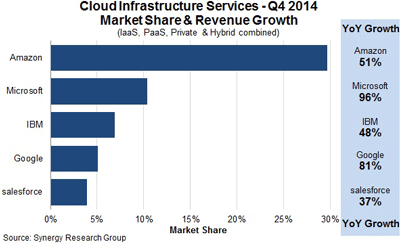Despite Microsoft's Wicked Acceleration, AWS Sets a Mean Pace on Cloud
The cloud successes that peppered Microsoft's most recent financial earnings report are helping Microsoft rack up higher growth rates on cloud revenues than any of the other major cloud infrastructure vendors.
Yet new industrywide data released by Synergy Research Group this week show that market leader Amazon's own consistently high growth rate, despite its comparatively huge market share, make Amazon Web Services (AWS) a tough-to-catch target.
In earnings statements and calls last week, Microsoft reported that commercial cloud revenues grew by 114 percent year-over-year, for the sixth straight quarter of triple-digit growth. Sales of its cloud products, including Office 365, Azure and Dynamics CRM, are at an annualized revenue run rate of $5.5 billion.
Synergy, which looks strictly at IaaS, PaaS and private and hybrid cloud, put Microsoft's year-over-year growth for the quarter slightly lower, at 96 percent. That was still good enough for the highest year-on-year revenue growth among the leaders. For the quarter, and for the year, Microsoft's share was 10 percent of a market Synergy valued at $5 billion and $16 billion, respectively.
Yet AWS remains in a league of its own. Amazon's share for the quarter hit 30 percent and for the full year was 28 percent. Despite enjoying triple the market share of its next closest rival (Microsoft), Amazon still managed 51 percent year-over-year growth for the quarter (see figure). The next three contenders after Microsoft were, in order, IBM, Google, Salesforce.com and Rackspace.
 [Click on image for larger view.]
[Click on image for larger view.]
"The momentum that has been built up at AWS and Microsoft is particularly impressive," said John Dinsdale, chief analyst and research director at Synergy, in a statement. "They have an ever-broadening portfolio of services and they are also benefitting from a slowdown in the super-aggressive price competition that was a feature of the first half of 2014."
Amazon's position remains strong, but the company is less dominant than it was earlier this year. After slipping in the second quarter of 2014, Amazon could no longer claim to be bigger than its four closest rivals, Dinsdale pointed out at the time.
Microsoft's 96 percent growth rate and Google's 81 percent growth rate in this latest quarter has to have Amazon focused on the rearview mirror in the IaaS/PaaS world. At the same time, Amazon is trying to turn the tables in the overall cloud market with the recent debut of Amazon WorkMail, which allows the company to come after Microsoft Office 365 and Google Apps.
Posted by Scott Bekker on February 05, 2015